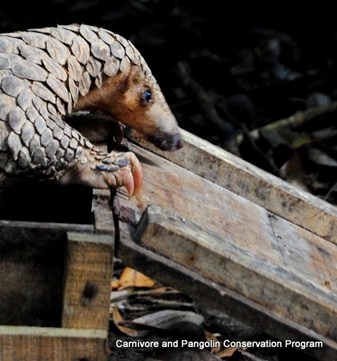The Sunda Pangolin, Manis javanica, is highly valued for its meat and scales. Across Southeast Asia individuals are caught and taken from the forest by local hunters and sold into the extensive illegal wildlife trade.
Often, it is live animals that are transported around. When local authorities uncover these shipments individuals are frequently released into the forest  immediately, in poor condition and with no monitoring of their survival. These individuals are often stressed and dehydrated, reducing their chances of survival. They may also be carrying diseases that could spread to wild populations.
immediately, in poor condition and with no monitoring of their survival. These individuals are often stressed and dehydrated, reducing their chances of survival. They may also be carrying diseases that could spread to wild populations.
The Carnivore and Pangolin Conservation Program (CPCP) in Cuc Phuong National Park remains CPCPone of the only places in Vietnam with local conservationists who are experts in pangolin rehabilitation. With many healthy individuals in their care they have been working with employees of Cat Tien National Park Forestry Protection Department (FPD) releasing these animals and monitoring their survival using VHF radio telemetry.
From this work parsimonious guidelines will be developed that can be implemented by the FPD for the conservation management of this species to encourage: the release of individuals in good condition; post release monitoring of individuals; and the management of releases in a way that will have a positive impact on the population in the park (i.e. establishing a viable population).
- P3 exploring her new environment shortly after being released.
So far the FPD rangers have been involved in basic care for injured pangolins, attaching a transmitter, and tracking animals after release. They have also been involved in dealing with any animal mortalities, which is notoriously high after confiscation. Although upsetting, it helps highlight the importance of doing things properly and acts as a reminder of just how difficult this species is to care for.
By monitoring individuals after release we can evaluate what contributes to the success or failure of a release. By tracking their survival, home range size and shape and sleep site selection we can begin to build up an idea of what factors are important to consider in a release program for this species.
Out for four individuals released, two were still alive after three months, unfortunately the fate of the other two was only followed for two weeks (until the transmitter fell off). However, we have found that these released individuals select sleeping sites in tree hollows, either in the trunk or at the roots, or inside hollow logs. It also takes approximately two weeks of exploratory behaviour before they establish a stable home range, which is a good indication they are able to find adequate resources.
We have also been trying to release individuals in locations where male and female home ranges may overlap. We had some (lucky) success with this when a released female was found in the same tree as a wild male! It also provided an opportunity to then tag and track a wild male. From this we found that although the home ranges of our released individuals were stable, they were small. These individuals had been in captivity for three years so it would be interesting to monitor the behaviour of those released as soon as their rehabilitation was complete to see what size home range they establish. Ideally, this is something that will be carried on by the FPD staff.
In order to develop release programs further, information needs to be gathered from a wild population. Once we have an idea of what a wild population looks like in terms of distribution, abundance and genetic make-up it can be used as a reference for release programs.
As with many species, a priority for the Sunda Pangolin is a decrease in hunting pressure. As this involves a long term attitudinal change, reinforcing depleted populations in areas that are well protected is a proactive and imperative move for this species.
by Louise Fletcher, of the Carnivore and Pangolin Conservation Program and member of the IUCN SSC Pangolin Specialist Group.








